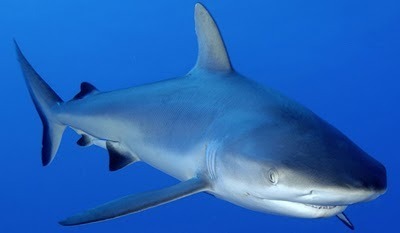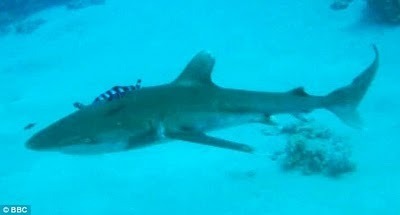Gordon Grice's Blog, page 101
December 18, 2010
Scientist injured by shark in the South Pacific

A grey reef shark (also known as a whaler) repeatedly bit a scientist with the Nature Conservancy. The man was trying to release the shark from a net in which it had become entangled. The man's injuries are minor.
The grey reef shark is a member of the requiem family, which includes the tiger, bull, and oceanic whitetips sharks, among others. Like many of its relatives, it is known to attack humans on occasion. It is not known to have killed anyone.
Kiwi's horror shark attack - national | Stuff.co.nz
Published on December 18, 2010 11:14
December 16, 2010
How to identify a shark on a biting rampage. - By Julia Felsenthal - Slate Magazine
How to identify a shark on a biting rampage. - By Julia Felsenthal - Slate Magazine: "From the diameter of the bite, scientists may be able to suss out the shark's size. The way that the victim's flesh is torn surrounding the points of incision can indicate the motion the shark used while biting; some sharks, particularly smaller ones, have the flexibility to vigorously shake their heads while attacking. Examining the bite marks, as well as the places where shark teeth scraped on human bone, can reveal whether the teeth had smooth or serrated edges."
Published on December 16, 2010 23:36
December 14, 2010
Deer versus Dog, Cat, Human
In British Columbia, a deer has thrashed a newspaper carrier. The man ended up with eight stitches and a black eye. He says he didn't see any fawn nearby, but of course fawns try hard not to be seen.
Another deer incident, from a few months back, was captured in this video. It features a domestic cat finding a fawn, to the discomfort of the doe. A dog gets involved too. Whether it was just passing by or had scented the fawn is impossible to tell from the clip. Violence ensues.
Published on December 14, 2010 09:50
December 12, 2010
Giraffe tramples man to death
Giraffe tramples man to death - Newsday: Everyday News for Everyday People
Giraffes are a traffic hazard in Africa, much like the deer are in North America. What we have here, though, is a far more unusual scenario: A giraffe purposely killing a human.
Giraffes are a traffic hazard in Africa, much like the deer are in North America. What we have here, though, is a far more unusual scenario: A giraffe purposely killing a human.
Published on December 12, 2010 12:56
December 11, 2010
Another fatal bull attack

In Britain, a farmer has died after an attack by one of his cattle:
Express.co.uk - Home of the Daily and Sunday Express | UK News :: Farmer dies after attack by his bull
Published on December 11, 2010 10:07
December 10, 2010
Red Sea Shark Attacks
 Matawan Creek, New Jersey
Matawan Creek, New JerseyRed Sea Shark Attacks: Killing Spree Puzzles Scientists - Yahoo! News
I'm not recommending this news report, which is a bit misleading on several points, but wanted to mention a couple of important items in it.
First, it quotes George Burgess of the International Shark Attack File confirming that one particular oceanic whitetip shark was responsible for at least two separate attacks. "We can actually say with certainty that one individual shark was involved in two of them without fail," he says. "That has not been documented before." I'd only add that while it hasn't been documented to a scientific certainty before, there's no real doubt that a single shark mauled three people in Matawan Creek, New Jersey, in 1916. One of those victims provoked the shark by trying to stop it from feeding on the child it had killed. The other two attacks were unprovoked. Two other people were taken by sharks in the ocean nearby around this time, but we can't be certain the same shark attacked them.
Scientists do not believe sharks ever take people as preferred prey. It would appear that the same shark rarely attacks more than one human in a lifetime. It's hard to be certain because it's difficult to prove which shark is responsible for a given attack.
The other important item here is an admission by the authorities that the sharks they caught last week were the wrong ones. "We did some efforts last week but I think we failed." and Salem Saleh, director of the Tourism Authority inSharm-el-Sheikh.
Published on December 10, 2010 13:15
Egypt shark attacks: 'Multiple species' behind attacks
A few clarifications. There have been three attacks. The first one injured two people. Early reports had the second one also injuring two, but the BBC is saying only one person was injured on that occasion. The third attack was the fatal mauling of a German woman.
As this story mentions, experts have studied the photos and confirmed that at least two different species are involved, including an oceanic whitetip shark and apparently a shortfin mako. Both of those species are known as kill people on occasion. The Egyptian government claimed that the mako it killed earlier this week was one of the culprits, but this seems doubtful. Its identity could be established either through its stomach contents or possibly by comparing it to the photo taken right before the attack.
BBC News - Egypt shark attacks: 'Multiple species' behind attacks
As this story mentions, experts have studied the photos and confirmed that at least two different species are involved, including an oceanic whitetip shark and apparently a shortfin mako. Both of those species are known as kill people on occasion. The Egyptian government claimed that the mako it killed earlier this week was one of the culprits, but this seems doubtful. Its identity could be established either through its stomach contents or possibly by comparing it to the photo taken right before the attack.
BBC News - Egypt shark attacks: 'Multiple species' behind attacks
Published on December 10, 2010 07:36
December 9, 2010
Shark Attacks: Livestock carcasses in the Red Sea?

One theory offered in explanation of the recent shark attacks in Egypt claims that the sharks were drawn by the carcasses of sheep in the water. This news report from a few weeks ago confirms that a ship did dump many carcasses and that the resulting pollution was heavy enough to cause concern at Sharm-el-Sheikh. According to the theory, scavenging sharks followed the drifting line of easy meals to the resort beaches where people were in the water.
Published on December 09, 2010 02:49
December 8, 2010
Blood in the Red Sea: Eyewitnesses Describe Shark Attacks

A British tourist took this photo of a victim pulled from the water after being mauled by a shark. The article linked here has eyewtiness accounts from two British couples.
Sharm-el-Sheikh shark attack: Photo shows blood in Egypt's Red Sea | Mail Online
Meanwhile, experts are saying the wounds indicate at least two different sharks are involved in the three separate attacks. Pictured below is an oceanic whitetip shark photographed just before one of the attacks and believed to be the culprit. Conservation officers killed a smaller oceanic whitetip and a shortfin mako shark, but there seems to be no evidence linking those two to the attacks.

Published on December 08, 2010 04:24
December 6, 2010
Deadly Kingdom cited in Cougar Story
Cougar sightings are controversial these days. Lots of people spot cougars, or think they do. Wildlife officials are often skeptical. This article does a great job explaining how that skepticism comes about. Coincidentally, it also cites a certain naturalist author with cougar experience.
Experts weigh in on cougar sighting | Denton Record Chronicle | News for Denton County, Texas | Local News
Meanwhile, in Alabama, a man survived an attack by a cougar (which in that part of the country is often called a panther).
Experts weigh in on cougar sighting | Denton Record Chronicle | News for Denton County, Texas | Local News
Meanwhile, in Alabama, a man survived an attack by a cougar (which in that part of the country is often called a panther).
Published on December 06, 2010 23:35



